1. Adv. Energy Mater. Overview: The commercialization prospects of nickel-rich anodes and the real problems they face
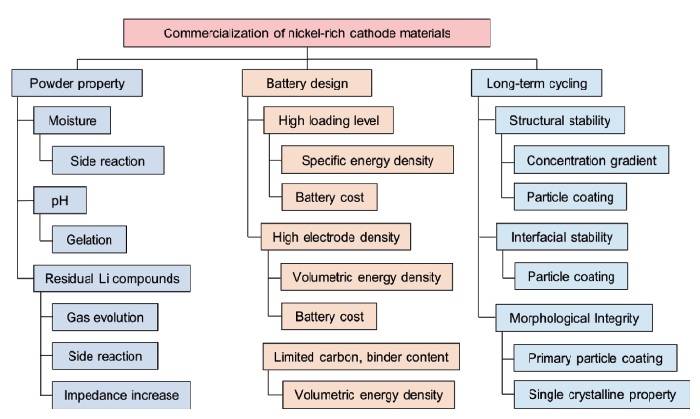
Figure 1: Requirements and considerations for the commercialization of nickel-rich cathode materials
The layered nickel-rich cathode material is considered to be an excellent cathode material for lithium ion batteries due to its large reversible capacity and low cost. However, nickel-rich cathode materials with a nickel content of more than 80% present significant challenges such as unstable powder properties and electrode density limitations in practical applications.
Recently, Minjoon Park and Prof. Jaephil Cho (Communication News) of the Ulsan National Institute of Science and Technology in Korea published a review article on nickel-rich positive electrodes on Adv. Energy Mater. This review summarizes the stability of nickel-rich cathode materials under industrial electrode fabrication conditions and the properties of nickel-rich cathode materials.
2. Adv. Energy Mater. Overview: Progress and Application of High Performance Thermoelectric Materials
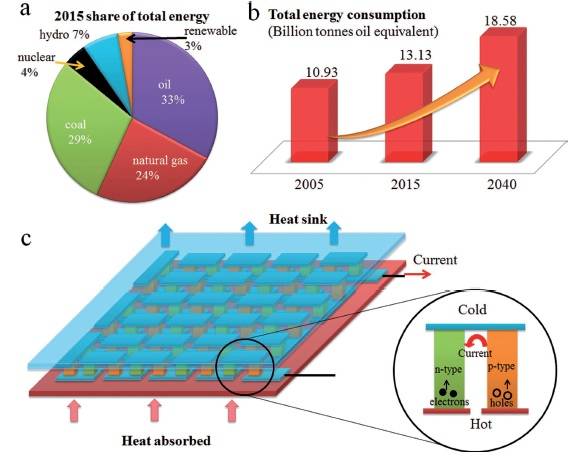
Figure 2: (a). Total energy share in 2015; (b) Energy consumption statistics and estimates; (c). Model of thermoelectric generators
Thermoelectric materials can convert thermal energy into electrical energy to improve fuel efficiency, and by collecting waste heat, provide a reliable alternative energy source for the industry, which provides a solution for finding new energy sources. Excellent thermoelectric materials are the key to the preparation of high-performance thermoelectric devices. The development of high-performance thermoelectric devices not only broadens the market for thermoelectric applications, but also enhances the enthusiasm of researchers for materials research.
Recently, Professor Zou Jin and Associate Professor Chen Zhigang (Communication News) of the University of Queensland and others published a review on thermoelectric materials in Adv. Energy Mater. This review summarizes new strategies for achieving high performance germanium materials and their major new applications. Among them, the carrier concentration and band structure of the manipulation material are effective ways to optimize the charge transfer performance, while the nanostructure engineering and defect engineering can greatly reduce the thermal conductivity close to the amorphous limit. Currently, thermoelectric devices are used in remote missions, solar thermal systems, implantable or wearable devices, the automotive industry, and many others; they are also used as temperature sensors and controllers and even gas sensors. The future trend in the field of thermoelectricity is to synergistically optimize and integrate all the effective factors to further improve the thermoelectric performance and make efficient thermoelectric materials and devices more beneficial to daily life.
3. Prog. Polym. Sci. Summary: Spirulina-assisted polymer induced stress
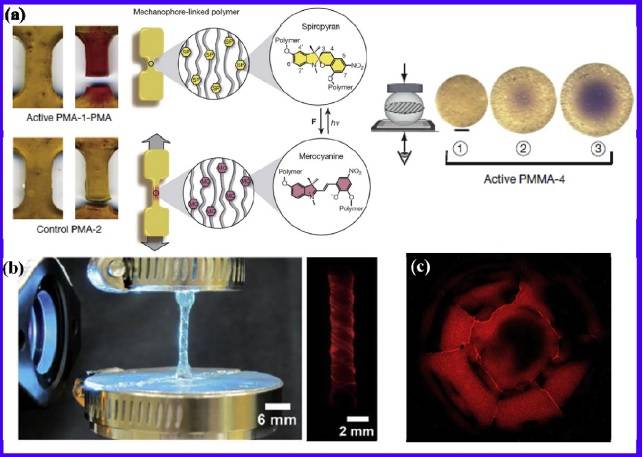
Figure 3: Mechanically induced sp activation in solid polymers
In recent years, mechanically responsive polymers have important applications in stress/strain sensing and damage warning, so such polymers have received a lot of attention from researchers. Recently, Professor Zhu Shiping (corresponding author) of McMaster University in Canada and others published a review on stress-sensitive polymers in Prog. Polym. Sci. In this review, the researchers proposed the mechanochemical flow of spiropyran (SP) and the influencing factors and applications of spiropyrans in various polymer systems. The final summary of the review highlights the limitations of spiropyrans in polymer applications and their future research directions.
4. Scripta Mater. Overview: Research progress of RFe12 compounds in permanent magnets
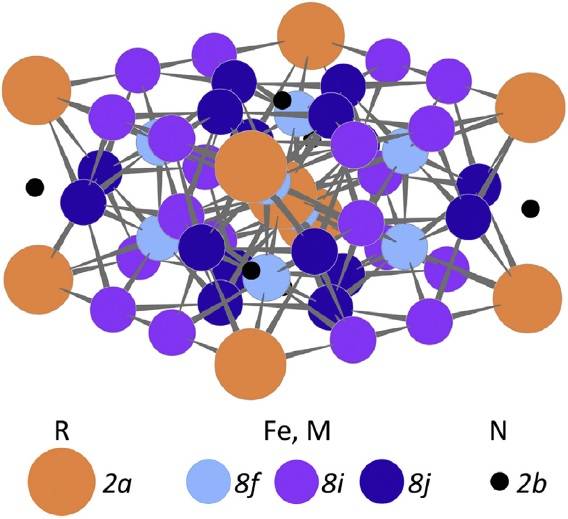
Figure 4: Square cell of R(Fe, M)12
ThMn12 type compounds have long been recognized as a class of potential permanent magnet materials, but their research has only gradually begun in recent years. Especially in the past four years, there have been many articles about the ThMn12 type compound in the field of permanent magnets. One is that Nd-Fe-B has developed to the limit of 520 kJ m-3 as the best magnet material, so the more promising ThMn12 type compound has once again received attention. The second is because magnet materials need to work in 175-200 ° C in a new generation of wind turbines and electric (hybrid) cars, and Nd-Dy-Fe-B and Sm-Co magnets can not afford this task. Therefore, it is urgent to develop new ferromagnetic materials to meet the needs of the new era.
Recently, Professor AM Gabay (corresponding author) of the University of Delaware and others published a review on the permanent magnets of RFe12 type compound in Scripta Mater. This paper reviews and analyzes the development of ThMn12 hard magnetic compounds and attempts to find the most promising permanent magnet materials. The paper also suggests that because mechanochemistry provides an opportunity to prepare anisotropic magnetic powders with high coercivity, researchers have shown strong interest in the preparation of anisotropic magnetic powders using Ce-substituted and rare earth-free compounds.
5. Chem. Soc. Rev. Overview: Phase separation in organic aerosols
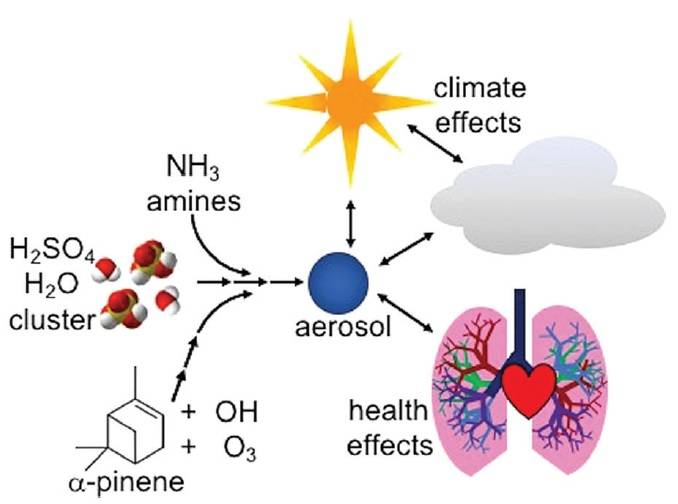
Figure 5: Impact of aerosols on climate and human health
Organic aerosols are ubiquitous in the atmosphere. They are usually composed of organic compounds and salts. On the one hand, they affect the scattering of sunlight. On the other hand, aerosols become the core of dark clouds and affect the climate. Historically, scientists believe that the formation of organic aerosols requires two phase changes: weathering (crystallization) and deliquescence (water absorption). However, a new view put forward in the past decade or so suggests that organic aerosols can undergo liquid-liquid phase separation, eventually forming two liquid phase particles. In recent years, researchers have conducted detailed research on liquid-liquid phase separation, and its mechanism has also developed into the stage of theoretical models.
Recently, Professor Miriam Arak Freedman (communication author) of Binzhou State University and others conducted a systematic review of these studies. The experimental results of recent studies are summarized, including the latest results on inhibition of liquid-liquid phase separation.
6. Chem. Soc. Rev. Overview: 3D Printing in Chemical Engineering and Catalytic Technology: Structured Catalysts, Mixers and Reactors
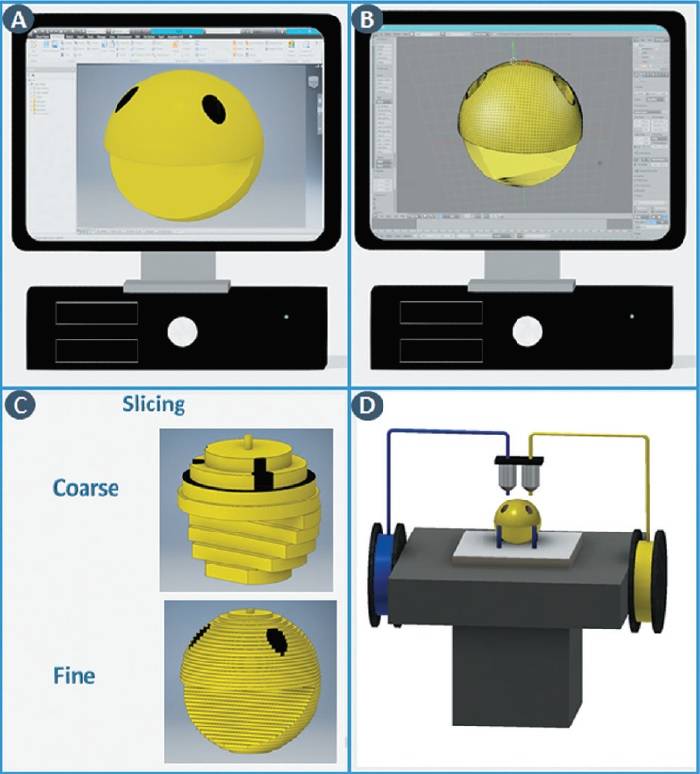
Figure 6: 3D printing process: (a) designing 3D objects using CAD; (b) converting the model into 3D printing format; (c) digitally slicing the model; (d) final layering the object
3D printing technology, combined with computer-aided manufacturing techniques and analog data processing methods, is changing the way in which functional objects are manufactured and designed. In addition, in the field of catalytic technology and chemical engineering, the preparation is regulated by additives, which is also called 3D printing. While 3D printing technology is still in its early stages, the rapid and seamless transition between digital data and physical objects achieved by these manufacturing tools will help to research and manufacture reactors and structured catalysts.
Recently, Professor Simon Kuhn of the University of Leuven and Rob Ameloot (co-author) and others published a review on Chem. Soc. Rev. on the use of 3D printing technology to assist chemical catalytic reactions. This review highlights a series of research results using 3D printing and computational models as digital tools to design and manufacture reactors and structural catalysts. The research will promote the close integration of chemistry and materials science, as well as the interaction of digital manufacturing and computational models.
7. Chem. Soc. Rev. Overview: Control of electrochemical processes using energy harvesting materials and devices
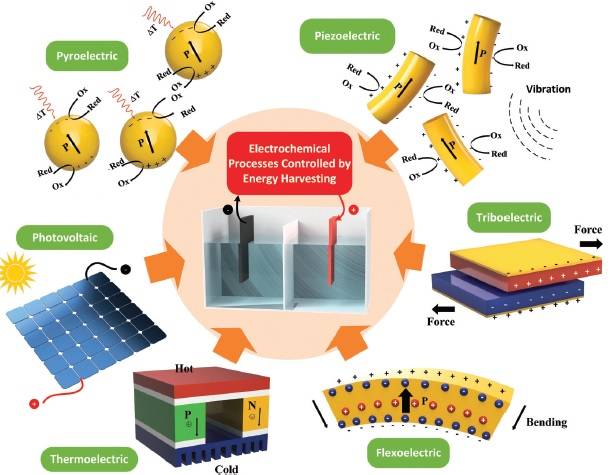
Figure 7: Application of various energy harvesting devices to control electrochemical processes
Today, energy harvesting is an extremely hot topic, and its purpose is to transform various forms of energy in the environment, such as mechanical motion, light and heat, into energy that can be used by humans. In many cases, heat or light is converted to electrical energy by thermal electronics and photovoltaic devices, which are then rectified and stored in capacitors to power the electronics; or wireless and self-powered sensors and low Power electronics.
Recently, Yan Zhang, a researcher at the University of Bath in the United Kingdom (corresponding author) and others published a review on the application of energy harvesting devices to control electrochemical processes in Chem. Soc. Rev. The article reviews some of the emerging energy storage fields in recent years with the aim of directly coupling energy harvesting materials and equipment to electrochemical systems. The principles of energy harvesting include pyroelectric, piezoelectric, electrical, substation, thermoelectric, and photovoltaic effects. These energy harvesting devices are used to influence various electrochemical systems, such as applications related to water decomposition, catalysis, corrosion protection, contaminant degradation, bacterial disinfection, and material synthesis. In addition, the review provides a detailed description of the energy harvesting method and its details of the electrochemical process control modes. At the same time, the future direction of the development of electrochemical acquisition systems is also discussed, and the potential of new applications and hybrid methods of the system is prospected.
8. Acc. Chem. Res. Overview: Understanding the template effect in ionic liquids at the molecular level
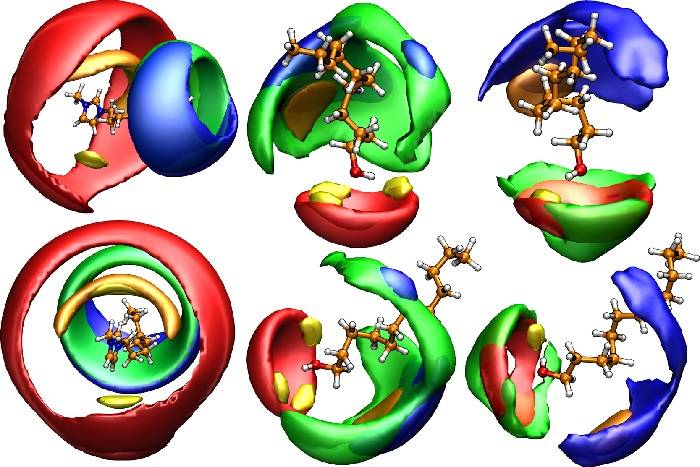
Figure 8: Spatial distribution function of [C8C1Im]+cationic solution (left), lauryl alcohol solution (middle) dissolved in [C8C1Im][NTf2] and lauryl alcohol solution (right) dissolved in [C2C1Im][NTf2]
Researchers often use structure-directed effects and template effects to explain the differences in ionic liquid synthesis, that is, the cause of the differential synthesis results may be due to the geometric arrangement of different scaffolds or different ionic liquids. This effect may be due to the most likely complex microstructure that exists in the ionic liquid itself. At present, the microscopic heterogeneity of ionic liquids is still the mainstream cognition, but its understanding at the molecular level is still insufficient.
Recently, Professor Oldamur Hollóczki and Professor Barbara Kirchner of Bonn University (co-author) and others published an overview on Acc. Chem. Res. This review provides a detailed molecular level understanding of ionic solutions and structural orientation and template effects from molecular structure.
A Bolt is a type of fastener consisting of a head and a Screw (a cylindrical body with external threads), which needs to be used in conjunction with a nut to tighten and connect two parts with through holes,
Hexagon Bolt,Hexagon Head Screw,Hexagon Screw,Hexagon Head Bolt
AM FASTENER , https://www.asmefastener.com